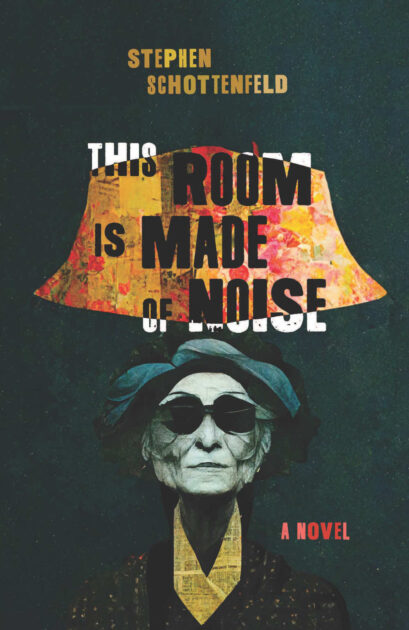In Stephen Schottenfeld’s This Room Is Made of Noise, a down-on-his-luck handyman befriends an elderly widow of means. What’s a reader to think?
Schottenfeld to read at Plutzik Reading Series
Wednesday, April 12 at 5 p.m.
Hawkins-Carlson Room, Rush Rhees Library
Free and open to the public
Stephen Schottenfeld will read from his new novel, This Room Is Made of Noise (University of Wisconsin Press), as part of the annual Hyam Plutzik Memorial Reading Series. Award-winning poet and Rochester professor of English Jennifer Grotz will also read from her forthcoming collection, Still Falling (Graywolf Press).
The Plutzik Reading Series, sponsored by the Department of English and now in its 60th year, is one of the oldest literary reading series in the United States. It has featured prominent Rochester faculty members in addition to such guests as John Ashbery, Louise Glück, Salman Rushdie, Margaret Atwood, James Baldwin, and many others. The series is named for the poet Hyam Plutzik, who taught at Rochester from 1945 until his death from cancer in 1962. Plutzik’s death at age 50 cut short an extraordinary career in which he had published three collections of poetry, and been named a Pulitzer Prize finalist for all three: Aspects of Proteus (1949), Apples from Shinar (1959), and Horatio (1961).
It may seem paradoxical that Stephen Schottenfeld’s new novel, This Room Is Made of Noise (University of Wisconsin Press), should be described on its back cover as “quietly mesmerizing.” But within that paradox lies a truth at this story’s core.
A simple conversation between two people—an exchange of pleasantries, even—contains multitudes.
“A single moment just contains so many different possibilities,” says Schottenfeld, an associate professor of English at the University of Rochester. “You look inside that moment, and you just see more and more implications.”
The novel, which is set in Rochester, New York, is narrated by handyman Don Lank, whose mind can be a noisy place as it moves from moment to moment. Divorced and in his 40s, Don has done OK for himself as single proprietor of Don’s Fix-It. But one mishap—a missed insurance payment amidst the turmoil of his marriage’s last days, followed by a leak on roof work he’d just completed (“some error at the ridge,” he explains)—and he finds himself $20,000 in the hole. To dig himself out, he develops a side gig buying and selling used goods.
All that is backstory, which Don shares in time. The book opens with the first encounter between Don and an elderly widow named Millie Prall, who lives alone in a big house on a grand boulevard in the Rochester suburb of Irondequoit.
“I was driving past the big houses on Thomas Avenue when I caught, across the street, these pretty shades glowing in a window,” the story begins. “A twelve-light table lamp. A Tiffany Lily, it looked like, but a copycat, I was sure.”
Don stops the car and approaches the house. When he rings the doorbell, Millie greets him. He asks if she is willing to sell the lamp and offers her $800 for it.
The lamp, which turns out to be a genuine Tiffany, foretells the story to come. It’s a tale that delves into the idea of authenticity—verifiable in the world of Tiffany lamps and their many imitations, but much murkier in the realm of human relationships.
Who is Don, and what does he want? Having unexpectedly pocketed $15,000 for the lamp, Don decides to return most of it to Millie. That one act marks the start of a relationship. Millie hires Don for a couple of small jobs, but Don sees more work to be done. The house is a maze of potential dangers for Millie, well into her nineties and living alone with no close family left and few acquaintances. Don also learns that Millie has some means that extend beyond the equity in her house.
The tension of the story lies in the question of motives. At any moment, we are never sure what Don’s are. Don isn’t sure either, as we learn from his penchant for rumination.
At the same time, Millie becomes more and more demanding, and her needs grow as she slips into dementia. If manipulation is part of the tie that binds them, who is manipulating whom? As the stress wears on, what is Don capable of?
Conversely, might this turn out to be a story of a different set of possibilities—of generosity, grace, and connection?
 How do you create a character? Research, reflection—and always, rewrites
How do you create a character? Research, reflection—and always, rewrites
“I usually start with a character, and the story flows from that,” Schottenfeld says of his approach to fiction writing. Most often his characters take shape around the rhythm and routine of work lives. In an endorsement of the novel, the National Book Award–winning fiction writer Alice McDermott writes, “Schottenfeld writes about work—the dailiness of it, the paycheck of it, the way it slowly and inevitably shapes a life—with an authority few contemporary novelists can match.”
Notably, those work lives are frequently very different from his own. The protagonist in his first novel, Bluff City Pawn (Bloomsbury, 2014), owned a pawn shop. And as for Don, “I don’t know if someone is less handy than I am,” Schottenfeld says. “If you saw me holding a power tool, you’d probably say, like, ‘put it down.’ You would not want me working on your house.”
Schottenfeld writes not about what he knows, but what he comes to know through deep research. In the case of Don, part of that research meant spending time with handymen, asking them, sometimes over meals, about their various jobs, processes, interactions with clients, and what they did, say, in just the past week. He occasionally shadowed them, too, to pick up on the smallest details. “There was a guy that I went to Lowe’s with,” he says. “I told him, ‘I just want to see how you get supplies in the morning.’”
Then there’s harder work: fleshing out the backstory, the longings, the preoccupations, and the idiosyncrasies that make an imaginary human being, going about the day, seem real. Schottenfeld says drawing out the character of Don was the hardest part of his writing. Don didn’t truly take shape until the second draft.
“There’s a difference between something being suggested and something being absent,” says Schottenfeld, explaining that in an initial draft, Don “wasn’t sufficiently on the page yet.” He spent an additional year working on the novel, “just leaning into the emotional weight and significance of some of the moments that I had written past.”
Local readers of the novel will recognize another character: Rochester itself. This Room Is Made of Noise includes some familiar place names, such as Rochester General Hospital, the town of Henrietta, and Thomas Avenue, in Irondequoit. We also learn that Millie’s late husband enjoyed a decades-long career at Kodak. That detail alone evokes a particular time and place in Rochester’s past that have come to define prosperity and financial security, built from generous salaries, bonuses, and pensions.
Schottenfeld sees Rochester as having played something like the role of a supporting character—at least in comparison to the role of Memphis in his debut novel. “In writing about a pawnshop—and there were so many in Memphis—I think I was inevitably saying something, in Bluff City Pawn, about the city. My attention in Room is more focused on what transpires between Don and Millie.”
What transpires cuts across the intersecting themes of “work, memory, money, family, isolation, aging, caregiving,” he adds. “And yet, I suppose I’m still exploring similar territory in both novels—jobs and relationships and the emotional and financial transactions made in a room.”
Read more
 Debut novel explores betrayal, brotherhood in the South
Debut novel explores betrayal, brotherhood in the South
Tough economic times can bring out the worst in people, especially when you mix in family, desperation, and the drive to get ahead in business. This is one of the messages in Bluff City Pawn.
 Novelist Joanna Scott returns to short stories in Excuse Me While I Disappear
Novelist Joanna Scott returns to short stories in Excuse Me While I Disappear
The acclaimed writer and University of Rochester English professor explores the theme of ‘lost stories.’
 English professor’s cotranslation of poetry wins PEN American Literary Award
English professor’s cotranslation of poetry wins PEN American Literary Award
Everything I Don’t Know, translated from the Polish by Jennifer Grotz and Piotr Sommer, took top honors for poetry in translation in 2022.




